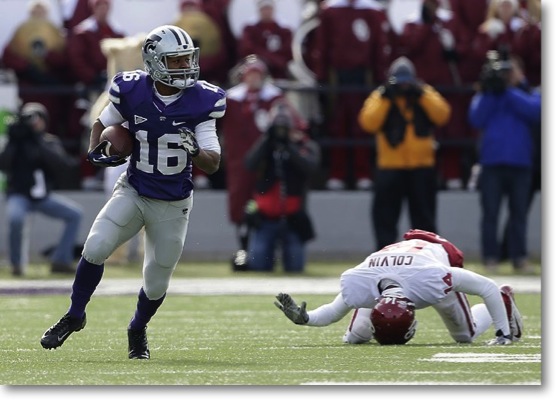
Tyler Lockett is a rather frustrating assignment (via)
We're back! I'm here to tell you, after watching Kansas State's 41-31 loss to Oklahoma, that Michigan's upcoming bowl opponent is very bad at defending mobile quarterbacks, which is a great sign for... wait, say that again?
Oh.
Well, the Sooners pulled away in the second half of this game on the strength of a 200-yard rushing performance from RB Brennan Clay and another 82 yards on the ground from backup quarterback Trevor Knight, who filled in admirably for injured starter Blake Bell and is quite a bit faster than Shane Morris. The Wildcats, on the other hand, couldn't establish anything on the ground, tallying 66 yards on 19 carries (sacks removed) while playing from behind for most of the contest. Is any of this relevant to Michigan? I have no idea! Let's talk about it anyway.
OFFENSE
Spread, Pro-Style, or Hybrid? Spread. It's possible that KSU is closer to a hybrid, as they did show some I-form looks and utilize a fullback even in some shotgun formations, but in this game they were almost exclusively in the gun and utilized plenty of spread concepts.
Basketball on Grass or MANBALL? This game didn't provide a great look at KSU's run game; when they did, they mixed in a healthy amount of zone read with more traditional power runs, a couple end-arounds, and far less of the misdirection-type stuff Brian pointed out in his early look at the Wildcats—likely due to circumstance more than a change in philosophy.
Hurry it up or grind it out? Grind it out. The home crowd at Kansas State spent much of the game counting down the final ticks of the play clock to help out their quarterbacks; they take their sweet time between plays, and given how Michigan has fared against high-tempo offenses this year that's fine by me.
Quarterback Dilithium Level (Scale: 1 [Navarre] to 10 [Denard]): Bill Snyder has utilized a two-quarterback system for much of the season; like Northwestern's Colter/Siemian duo, the Wildcats feature a pocket passer, Jake Waters, and a run-first threat, Daniel Sams. Waters is more mobile than Siemian and is utilized in the read-option game, though mostly as a means to keep the defense honest—he's not particularly fast or elusive, so I'll give him a 4. Sams, on the other hand, rushed 148 times at 5.2 ypc against just 52 pass attempts; he gets a strong 8, with the caveat that he barely featured in this particular game.
[Hit THE JUMP for the rest of the breakdown.]
Dangerman: 5'11" junior receiver Tyler Lockett emerged as the team's go-to offensive threat this year after being a secondary pass-catching option and extremely dangerous return man in his first two seasons. Oklahoma opted to single-cover him for much of this game. It did not go well.
Lockett finished with 12 receptions for 278 yards and three touchdowns (the one not shown above came when Oklahoma's safety completely blew his assignment, allowing a Gallon-against-Indiana open bomb for a score). In addition to that, he returned five kickoffs for 162 yards (32 ypa) and would've had about 60 more yards if he hadn't been the victim of a touchdown-saving horse collar tackle.
On the season he has 71 catches at over 16 yards per pop; while he's yet to go take one the distance this season despite winning Big 12 Special Teams Player of the Year, he had four kickoff return touchdowns in his first two seasons. With great speed, solid hands, and exceptional elusiveness in the open field, he's going to be a very tough matchup.
Zook Factor: Nothing Snyder did qualified here.
HenneChart: While both Waters and Sams played in this one—albeit sparingly in the case of Sams—only Waters attempted a pass. This isn't unusual; excise the Oklahoma State loss in which he attempted 21 passes and tossed three picks and Sams hasn't had a game in which he threw the ball more than eight times—in the final two games of the season he didn't record an attempt. He was given the second drive of this game, had two ineffective runs, and was pulled for Waters on third-and-medium; he got one more snap, another QB keeper, the rest of the game.
Waters, meanwhile, had an up-and-down performance while alternating between chucking it deep and throwing quick hitches to the perimeter, mostly to Lockett. He throws a pretty nice deep ball despite lacking great arm strength; in fact, his arm hampers him more on the shorter throws, which often took a while to get to their target. He seems to overthrow the ball in an attempt to overcome this—he sailed several short-to-intermediate passes. Chart (chart).
| Opponent | DO | CA | MA | IN | BR | TA | BA | PR | SCR | DSR |
|---|---|---|---|---|---|---|---|---|---|---|
| Oklahoma | 2 | 17 | 2 | 7* | 1* | 2 | 1 | 4 | -- | 66% |
Not a bad day overall, though both the INX and BRX resulted in interceptions, the former a panicked throw in the face of a blitz that went to the wrong shoulder on a hitch (returned for a touchdown) and the latter a desperation heave into three defenders when down ten points in the last few minutes.
OVERVIEW
Formation chart:
| Formations | Run | Pass | PA |
|---|---|---|---|
| Gun | 12 | 31 | 4 |
| I-Form | 4 | -- | -- |
| Ace | 2 | -- | -- |
| Pistol | -- | -- | -- |
Circumstance dictated much of KSU's playcalling. On their first two possessions, they finished run-run-pass while going four-and-out and three-and-out (the first play of their opening possession was a run that netted a first down). After the Sooners jumped out to a 14-0 lead, Kansas State started airing it out and continued doing so even after they'd tied the game at 14 and 21; it didn't help that their defense immediately ceded the lead back to Oklahoma each time.
| Down | Run | Pass | PA |
|---|---|---|---|
| 1st | 10 | 15 | 2 |
| 2nd | 7 | 7 | 2 |
| 3rd | 1 | 10 | -- |
Because their offense in this game was either throws beyond the sticks or runs well short of them, Kansas State ended up in a lot of third-and-long situations—their lone third-down run came from the Oklahoma one-yard line after Lockett drew a pass interference in the end zone.
The issues on offense mostly stemmed from a subpar performance from the offensive line. In the run game, they simply couldn't move Oklahoma off the line of scrimmage, and the right side of the line—featuring 290-pound guard Keenan Taylor and 280-pound tackle Tavon Rooks—often gave way entirely. In pass protection, they fared well when faced with a four-man rush but were overwhelmed when Oklahoma blitzed, allowing three sacks and several pressures in those situations.
Running back John Hubert finished with 17 yards on nine carries, mostly as a result of the line's inability to open a hole; he didn't look like the type to make big plays on his own. He was often lifted in the second half in place of a fullback for pass protection; KSU also stuck an H-back in the backfield—often directly in front of the fullback—and either flared him out or used him for extra protection.
While KSU prefers to be a run-heavy team, their most dangerous players line up at receiver. Lockett is obviously the primary concern—he's got 35 more catches than the next-closest Wildcat. Trumaine Thompson is another big-play threat, averaging nearly 18 ypc this year; he hauled in a 43-yard catch in this one and displayed impressive speed on a pair of end-arounds—it's notable that KSU utilized him in that role instead of Lockett. Curry Sexton plays the role of underneath possession receiver and had just one catch against Oklahoma.
PLAY BREAKDOWN
For the most part, KSU's offense depended on bombs to Lockett in true boom-or-bust fashion. However, their most consistently successful play was a slick draw-bubble-slant packaged play, which they ran five times and got four solid completions, all to the slant. Here's the setup:
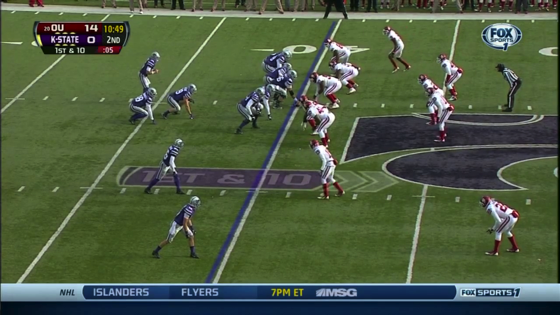
At the snap, Waters pauses before taking a stutter-step forward as the two backs lead block. The slot receiver runs a bubble screen while the outside receiver runs a ten-yard slant. Waters has a few options, of course. He reads the playside linebacker; if the defense is playing a soft man (as they are in this case) or a Cover 2 and the linebacker steps up to defend the run, Waters throws the slant. If the slot receiver is uncovered or the Cover 2 corner sinks too far with the slant, he throws the bubble. If the linebacker stays home, he pulls it down and runs a draw.
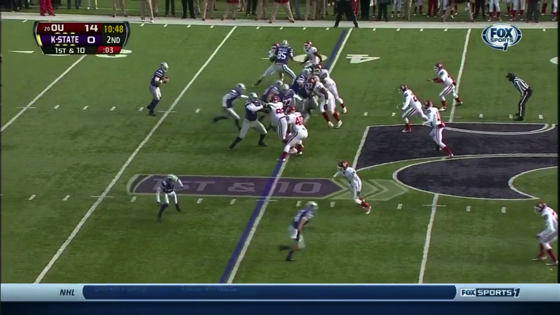
In this case, the bubble is covered and the linebacker is slowly shuffling towards the line of scrimmage, which becomes more apparent in the next frame. Oklahoma is playing man coverage with plenty of cushion on the outside. As the linebackers move towards Waters...
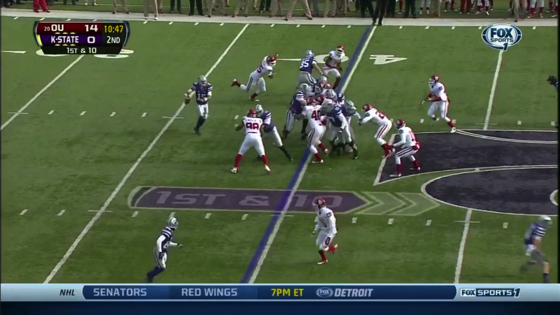
...he pulls up and throws the slant.
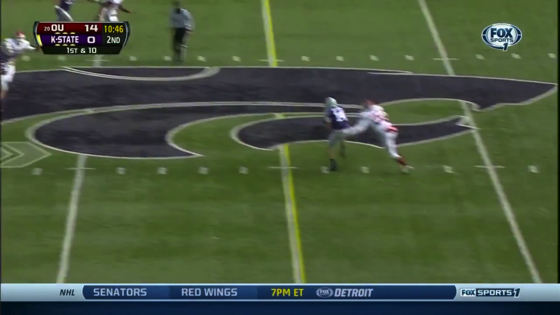
As you can see, there's a huge gap between the linebackers and the coverage behind them; the corner does well here just to keep this from going a loooooong way.
Video:
Packaged plays like this one are tough to defend when run correctly and Waters has this one down. Michigan plays more zone than Oklahoma did in this one, which makes it more likely that Waters has to pull the ball down and run—that's preferable given his lack of explosiveness.
DEFENSE

I be like dang, Ryan Mueller (via)
Base Set? 4-3 over.
Man or zone coverage? KSU mixed up their coverages a fair amount, with one common thread—they played well off Oklahoma's receivers on the outside, either playing a soft man or dropping at least three defensive backs deep. More on this later.
Pressure: GERG or Greg? Quite GERG-ian. Kansas State barely blitzed and when they did it was sending their nickel off the edge in an attempt to slow down Oklahoma's read-option attack.
Dangerman: Weakside DE Ryan Mueller earned Big 12 Defensive Lineman of the Year honors this season, tallying 11.5 sacks, 18.5 tackles for loss, four forced fumbles, and six pass breakups (tipped passes at the line, I assume). He's an explosive rusher off the edge and in this game was the only Kansas State lineman who consistently beat blocks, though the lack of help meant Knight was able to elude him without much issue. He had some trouble shedding blocks against the run against a physical Oklahoma offensive line.
OVERVIEW
Unless someone breaks tendency, this game will feature two bend-but-don't-break defenses. While KSU's raw numbers are solid, Brian pointed out that the advanced stats aren't kind to them; they certainly got thrashed in this game, ceding 5.8 yards per rush and 8.1 yards per pass.
Aside from Mueller, the defensive line really underwhelmed. While much of Oklahoma's success came from the read-option, Clay also had a huge day on non-option runs as his line essentially allowed him to choose which giant crease to run through:
Repeatedly.
Despite the disruptive presence of Mueller, the Wildcats are 85th nationally in tackles for loss. If Michigan's offensive line has progressed during bowl practices, they could find success pounding the rock, even without the threat of Devin Gardner out there.
Given how easy it was to block the defensive line, the linebackers didn't get a chance to make many plays; if one did, it was usually MIKE Blake Slaughter, who leads the team by a healthy margin with 103 tackles. He's a very sure tackler and held his own when not eating blocks right off the bat. I was also quite impressed with weakside linebacker Jonathan Truman, who always seemed to be around the football despite being quite undersized at 5'11", 219 pounds.
Oklahoma only threw the ball 21 times, so I didn't get a great look at the secondary; if the vanilla schemes and soft coverages are any indication, however, these guys can be picked on. Oklahoma was able to do almost all of their damage on underneath catch-and-runs and broke a couple big plays when the safeties blew tackles; it didn't help that KSU's best defensive back, safety Ty Zimmerman, missed the game with an injury—he's healthy and should patch up some of the tackling woes that plagued KSU against both the run and the pass. That said, Jeremy Gallon should have every opportunity to break the single-season receiving mark, because...
PLAY BREAKDOWN
...when I say soft coverage, I mean soft coverage. This is a third-and-six for Oklahoma in their own territory and they come out in a shotgun trips look. KSU doesn't hide the fact that they're playing man coverage. Those men are also lined up past the sticks even before the snap:
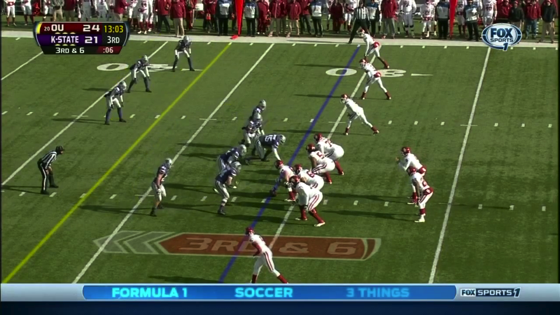
The inside slot receiver, Jalen Saunders, runs a quick slant that's so open Knight throws it before the two other receivers have started their breaks:
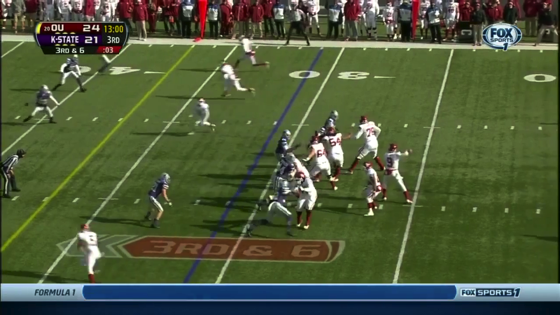
Saunders makes the grab in a four-yard bubble of open turf:
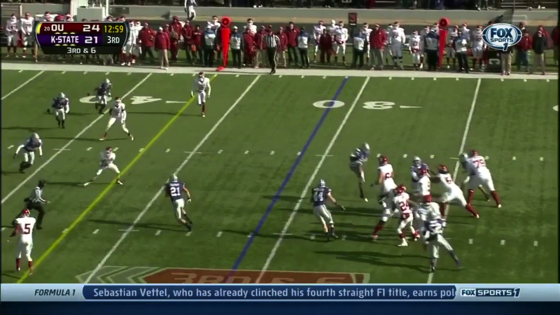
He proceeds to turn it upfield for a 48-yard gain before fumbling; Oklahoma is lucky to recover, but that's not the point. Video:
I'd chalk that up to a one-time RPS-minus but for the fact that this happened two more times in the same quarter. Both would've been similarly huge gains if not for inaccurate throws from Knight. This one forced Saunders to go the ground to make the first-down grab with even more running room than the above play:
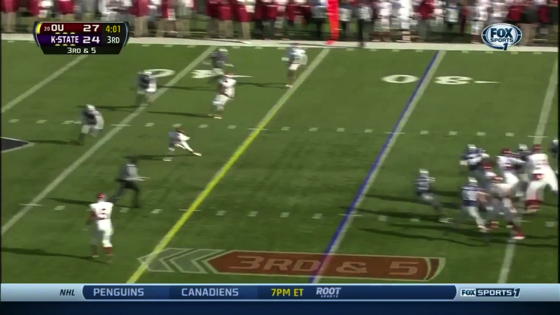
Knight flat-out sailed this throw over Saunders' head, in addition to throwing behind him, and it resulted in a near-interception instead of a potential touchdown:

I'm pretty sure Shane Morris can make that throw. Al Borges may not like calling a bunch of underneath passes; Kansas State's scheme is just begging for death by slants, though. I won't dare guess how that will turn out.